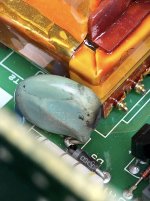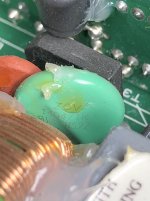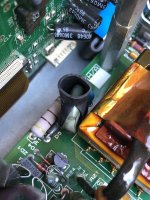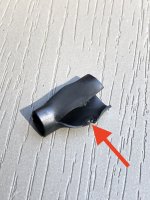Hello all,
I have a Myriad Mi Integrated Amp that has been running well until recently. It hasn't been used for about 9 months and the first time I was listening to it after that it was fine for about 20 minutes and then the amp wend dead, I heard an on-and-off 'buzzing' noise for a few seconds, and then I saw smoke. I pulled the plug and opened it up.
After some investigation it seems that a Varistor (one of two) has blown. In the attached image it is circled in red, it is labelled 'VDR2' on the PCB, the second one is circled in yellow and labelled 'VDR1'.
All other components seem okay to the naked eye.
The two Varistors seem identical. Due to the location of the blown one I can not make out all the markings at the bottom but comparing it to the markings on VDR1 they seem to be identical components (see attached photos). The text that I can clearly read states "ZOV 14D471K (various certification markings) CH52Z".
Some observations that I found interesting were that (a) the two Varistors seem to be identical yet the blown VDR1 is a paler green to the good VDR2, and (b) the failed VDR1 had some heat shrink completely covering it which burned through when it failed.
As I understand it these Varistors are a layer of protection in the circuit to protect from over voltage spikes. Is it logical to assume that this was the cause or could it have just failed independently? If it is likely to have failed due to over voltage would that be coming from the mains supply or a failure upstream in the circuit?
So I have a few questions:
I have a Myriad Mi Integrated Amp that has been running well until recently. It hasn't been used for about 9 months and the first time I was listening to it after that it was fine for about 20 minutes and then the amp wend dead, I heard an on-and-off 'buzzing' noise for a few seconds, and then I saw smoke. I pulled the plug and opened it up.
After some investigation it seems that a Varistor (one of two) has blown. In the attached image it is circled in red, it is labelled 'VDR2' on the PCB, the second one is circled in yellow and labelled 'VDR1'.
All other components seem okay to the naked eye.
The two Varistors seem identical. Due to the location of the blown one I can not make out all the markings at the bottom but comparing it to the markings on VDR1 they seem to be identical components (see attached photos). The text that I can clearly read states "ZOV 14D471K (various certification markings) CH52Z".
Some observations that I found interesting were that (a) the two Varistors seem to be identical yet the blown VDR1 is a paler green to the good VDR2, and (b) the failed VDR1 had some heat shrink completely covering it which burned through when it failed.
As I understand it these Varistors are a layer of protection in the circuit to protect from over voltage spikes. Is it logical to assume that this was the cause or could it have just failed independently? If it is likely to have failed due to over voltage would that be coming from the mains supply or a failure upstream in the circuit?
So I have a few questions:
- Is the colour difference likely due to heat during or leading up to the failure or maybe a different batch, a potential cause of failure?
- Why would there be heat shrink over only one of the Varistors and not the other? Could that have caused overheating and premature failure?
- Can I just replace the failed Varistor with another ZOV 14D471K (of any manufacturer), turn on the Amp, and see what happens?
- Finally, whilst I'm 'in there' is there any point at all replacing and upgrading any of the other components - Cap upgrades for example?
Attachments
Varistors can simply fail with age. There is a diode nearby that seems to be connected in series with it though, I would check that for damage too and replace it
Interesting - It seems that the polymer coating over a standard MOV is or was intended to increase the insulation or render it somewhat safer with high mains voltages. It's hard to imagine how useful that would be when a MOV likely explodes in a sustained over-voltage event.
I've seen a couple of high power amps and appliances that had MOV fragments splattered around inside. I was never quite certain this was more a MOV failure than a voltage surge/spike event because replacing the MOV was sufficient to restore operation but just like simply replacing a fuse, there's no reason to expect that's going to be a reliable repair to anything unless you are certain the fault is external - i.e. mains supply/ground fault.
I've seen a couple of high power amps and appliances that had MOV fragments splattered around inside. I was never quite certain this was more a MOV failure than a voltage surge/spike event because replacing the MOV was sufficient to restore operation but just like simply replacing a fuse, there's no reason to expect that's going to be a reliable repair to anything unless you are certain the fault is external - i.e. mains supply/ground fault.
Last edited:
Varistor 300VAC/385VDC
Complex SMPS. As I can see, mains filter varistor is ok. The faulty one is hard to say the cause from the pics only. Schematic is highly advisable.
Voltage can rise due to old ELCOs, faulty resistor, old optocoupler, PWM chip, and possibly other issues.
Not an easy repair I would say.
Complex SMPS. As I can see, mains filter varistor is ok. The faulty one is hard to say the cause from the pics only. Schematic is highly advisable.
Voltage can rise due to old ELCOs, faulty resistor, old optocoupler, PWM chip, and possibly other issues.
Not an easy repair I would say.
The varistor is right next to what looks like the main power transformer in the SMPS. It's possible that it's simply failed as it's been in the presence of a hotter environment and thermal cycling has cooked it.
Varistor 300VAC/385VDC
Voltage can rise due to old ELCOs, faulty resistor, old optocoupler, PWM chip, and possibly other issues.
Not an easy repair I would say.
Hi overall feedback,
Do you think there is a great risk in initially replacing the Varistor and seeing what happens? If there is an issue elsewhere as you speculate would the new Varistor just blow again effectively doing its job?
Also, as some of you have mentioned its proximity to the transformer's heat could be a factor in the failure. Although it could just be coincidence the 'blow out' seems to have been right on the edge of the Varistor that was touching the transformer's corner - possibly increasing the heat as a factor.
For further reference I have included a photo of how I found the heat shrink in place on the Varistor, split open, and another of the heat shrink itself where you can clearly see the point of 'burn through' which will have occurred before the heat shrink split open. The question is did that burn occur from the heat of the transformer or heat generated during the varistor's failure?
I wonder if this failure of the heat shrink proceeded the Varistor failure of after. Is it possible that the heat shrink failed a while back becoming brittle with age, burning through being in contact with the transformer, the split opening up and allowing more heat from the transformer to age the Varistor?
If I just go ahead and change the varistor I'll be inclined to install it away from the board, the longer legs insulated, and bend it away from the transformer. Is there any reason not to do that?
Attachments
I would expect just another burned varistor in case it is not only heat.Do you think there is a great risk in initially replacing the Varistor and seeing what happens? If there is an issue elsewhere as you speculate would the new Varistor just blow again effectively doing its job?
If it burns again prepare yourself for lot of work.
It looks to me as if the MOV might be part of a primary-side snubber across the transformer primary. Not seen that before. If that's the case, I'd be wondering why the MOV is even conducting in the first place.
Bring the supply up on a dim bulb.. faulty SMPS's get exiting very quickly if unrestrained!
Bring the supply up on a dim bulb.. faulty SMPS's get exiting very quickly if unrestrained!
Bring the supply up on a dim bulb.. faulty SMPS's get exiting very quickly if unrestrained!
Sorry jaycee, what do you specifically mean by this? Remove the SMPS and bench-test it?
- Home
- Amplifiers
- Solid State
- Blown Varistor in Myriad Integrated Amp




